Whatman 滤膜 7064-4704 PET 0.4UM BLACK PET 0.4UM BLACK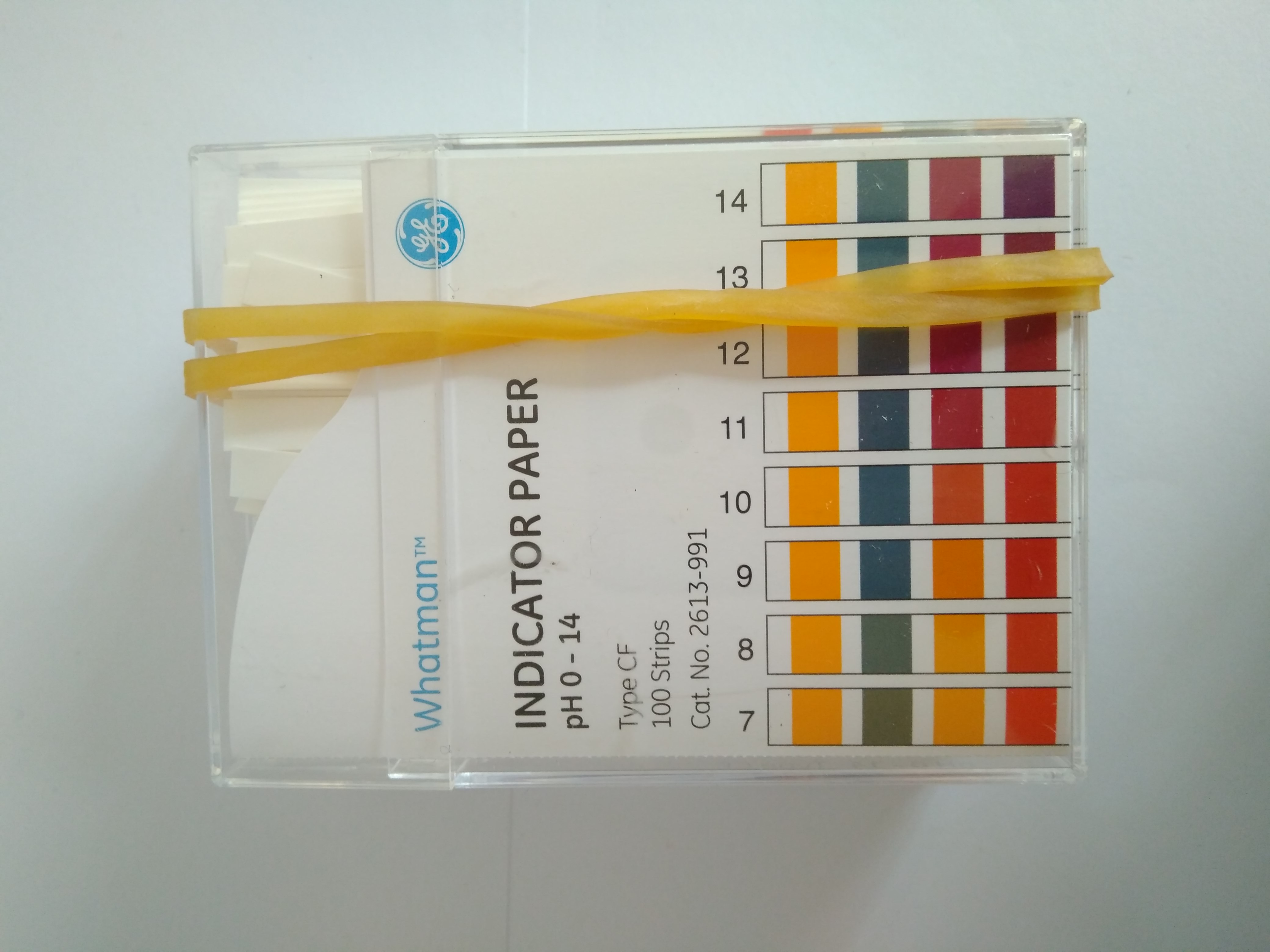
日度归档:2024年3月8日
荧光染料47070 Cyanine5.5 hydrazide 25 mg
lumiprobe荧光染料47070 Cyanine5.5 hydrazide 25 mg lumiprobe荧光染料Cyanine5.5 酰肼 25 mg 410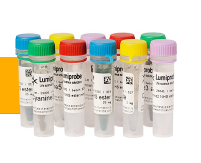
nunc 3744 Screwtube, 500uL w/cap, S
nunc 3744 Screwtube, 500uL w/cap, S
Whatman 滤膜 1001-125 1号滤纸圆型125mm/100
Whatman 滤膜 1001-125 1号滤纸圆型125mm/100 GR 1 12.5CM 100/PK
Whatman 滤膜 10312251 598滤纸1/2折叠型240mm/50
Whatman 滤膜 10312251 598滤纸1/2折叠型240mm/50 598 FF 240MM 50/PK
银耳多糖的特点与化妆品用途
银耳多糖的特点与化妆品用途 上海金畔生物科技有限公司
银耳多糖的特点与化妆品用途详解;银耳多糖(天然植物源透明质酸)又称为银耳异聚多糖;河北韩美的银耳多糖与其他物质的水溶液相比;银耳多糖作为保湿剂,主要应用于护肤品,以水剂类产;是水溶性的,在水相中添加,在水相中透明,特别适合;
银耳多糖的特点与化妆品用途详解
银耳多糖(天然植物源透明质酸)又称为银耳异聚多糖、银耳提取物。上海金畔生物科技有限公司生产的银耳多糖是水溶性多糖和碱溶性多糖。白色或类白色粉末,易吸湿,不溶于乙醇、丙酮和乙醚等有机溶剂。
上海金畔生物科技有限公司的银耳多糖与其他物质的水溶液相比,银耳多糖水溶液的蒸发速度是最慢的(P < 0.01)。同时能够保持490倍于自身重量的水,而透明质酸钠只能保持400倍。银耳多糖膜不容易随湿度的变化而收缩,所以运用与护肤品不会有紧绷的感觉。在透明质酸钠的膜上形成很多裂痕,但是在银耳多糖的膜上几乎没有形成裂痕。 说明其比透明质酸钠的膜更具有弹性、更柔软。提高了角质层水分含量,并且给皮肤柔软的感觉。提高了皮肤电导率积分值,提高皮肤的保水能力。降低了水释放常数,表明产品能提高皮肤的屏障功能,防止水分从皮肤的蒸发。透明质酸钠必须要配方中含有多元醇的情况下,才可以发挥保湿作用,而银耳多糖不需要。
银耳多糖作为保湿剂,主要应用于护肤品,以水剂类产品为主,如化妆水、乳液、精华液等,其他如膏霜、面膜、粉底等都可以用。一般粉剂推荐用量为0.02-0.2%。高端产品如精华液、面膜、眼霜中可适当增加用量。在膏霜中添加量不超过0.15%,否则会有拉丝现象。液态用量为2%–20%。
是水溶性的,在水相中添加,在水相中透明,特别适合用于透明的水剂类产品。 河北韩美生物科技有限公司的银耳多糖是天然植物来源,高安全性;而且是新物质,可增加化妆品卖点。银耳多糖作为保湿剂,应用范围广,几乎所有的配方中都可以添加;具有特有的滑爽感,配方工程师更容易接受哦。
OXOID培养基 CM0587B 产气荚膜梭菌TSC/SFP琼脂基础 PERFRINGENS AGAR BASE TSC/SFP 500GRAM
OXOID培养基 CM0587B 产气荚膜梭菌TSC/SFP琼脂基础 PERFRINGENS AGAR BASE TSC/SFP 500GRAM 1084.5589079808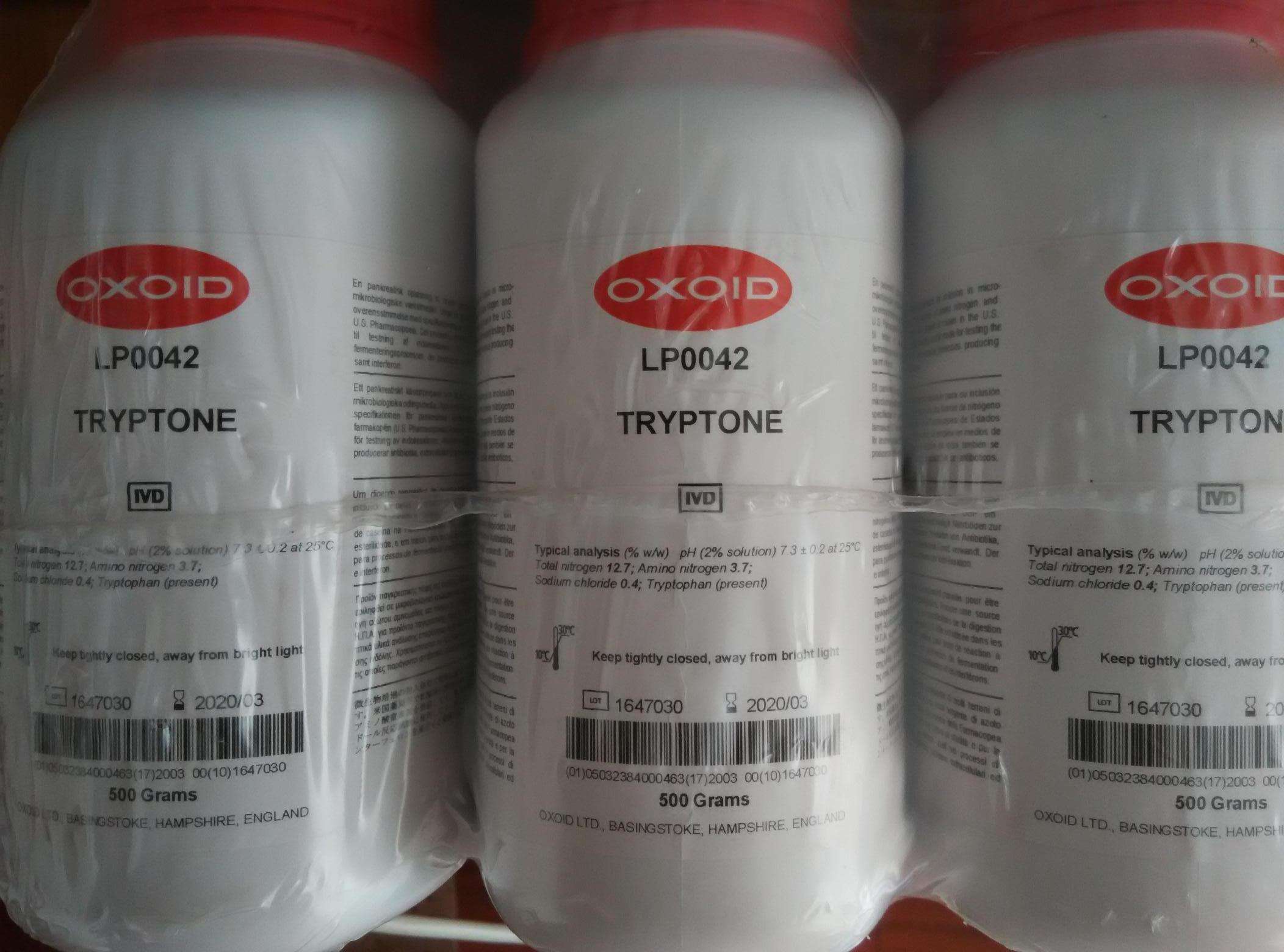
康宁corning 6569 SEALING TAPE,ALUMINUM,384WL,NS 384孔封口带 铝箔材质 未灭菌 100个/包
康宁corning 6569 SEALING TAPE,ALUMINUM,384WL,NS
384孔封口带 铝箔材质 未灭菌 100个/包 1包/箱 1002.22
放射线照射食品检测试剂
| 产品编号 | 产品名称 | 产品规格 | 产品等级 | 产品价格 |
| 191-15092 | 偏钨酸钠 | 25g | – | |
| 193-15091 | 偏钨酸钠 | 250g | – | |
| 200-17211 | 十四碳烷标准品 | 100mg | 气相色谱法 | |
| 207-17221 | 十四碳烯标准品 | 100mg | 气相色谱法 | |
| 168-23451 | 十五碳烷标准品 | 100mg | 气相色谱法 | |
| 084-08781 | 十六碳烷标准品 | 100mg | 气相色谱法 | |
| 084-08801 | 十六碳烯标准品 | 100mg | 气相色谱法 | |
| 081-08791 | 十七碳烷标准品 | 100mg | 气相色谱法 | |
| 052-07721 | 二十碳烷标准品 | 100mg | 气相色谱法 | |
| 082-08841 | 8-十七烯酸标准品 | 50mg | 食品分析 | |
| 089-08851 | 1,7-十六碳二烯酸标准品 | 50mg | 食品分析 |
放射线照射食品检测试剂![]()
■偏钨酸钠
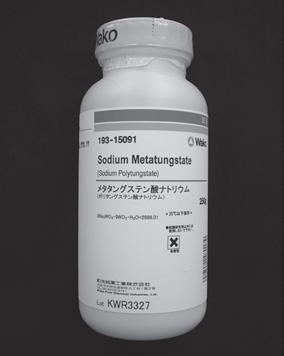
本品是使用于热发光(TL)法的偏钨酸钠。使用本品及专用设备可检测出经放射线照射的食品。
◆热发光(TL)法
经放射线照射,结晶内分离的电子和正孔受热刺激再次结合时, 产生荧光(发光)。检测到的荧光,根据放射线吸收线量物理性计算方法计算。(在食品中,分离附着在食品中的矿物质,检测荧光。)
◆参考方法
参考日本2008年5月29日公布的食安法第0529004号《关于经放射线照射的食物的检测法》。
◆检测对象
香料、蔬菜及茶(黑胡椒、姜黄、牛至<oregano>、灯笼椒、红辣椒、葫芦巴、孜然、芹菜籽、五香粉、黑芝麻、香菜、生姜、桂皮、欧芹、月桂、芥末、肉桂、香菇干、萝卜干、乌龙茶、红茶、麦茶、鱼腥草茶等)
| 产品编号 | 产品名称 |
规格 | 包装 |
| 191-15092 |
Sodium Metatungstate 偏钨酸钠 |
– | 25 g |
| 193-15091 | 250 g |
◆内部标准物质
| 产品编号 | 产品名称 | 规格 | 包装 |
| 081-01091 |
1mol/l Hydrochloric Acid 1mol/L盐酸 |
容量分析 |
100 ml |
| 083-01095 | 500 ml | ||
| 016-03146 |
Ammonia Solution 28%氨水 |
试剂特级 | 500 ml |
| 016-00346 |
Acetone 丙酮 |
试剂特级 |
500 ml |
| 012-00343 | 3 L |
||
| 043-16785 |
Distilled Water 蒸馏水 |
– |
500 ml |
| 047-16783 | 2 L | ||
| 041-16786 | 5 L |
■碳化氢法标准品
有用于碳化氢法的标准品可供选择。
◆检测对象
肉(鸡肉、猪肉、牛肉)、奶酪、植物种子(鳄梨、芒果、木瓜等)
| 产品编号 | 产品名称 | 规格 | 包装 |
| 200-17211 |
Tetradecane Standard 十四碳烷标准品 |
气相色谱法 | 100 mg |
| 207-17221 |
1-Tetradecene Standard 1-十四碳烯标准品 |
气相色谱法 | 100 mg |
| 168-23451 |
Pentadecane Standard 十五碳烷标准品 |
气相色谱法 | 100 mg |
| 084-08781 |
Hexadecane Standard 十六碳烷标准品 |
气相色谱法 | 100 mg |
| 084-08801 |
1-Hexadecene Standard 1-十六碳烯标准品 |
气相色谱法 | 100 mg |
| 081-08791 |
Heptadecane Standard 十七碳烷标准品 |
气相色谱法 | 100 mg |
| 052-07721 |
Eicosane Standard 二十碳烷标准品 |
气相色谱法 | 100 mg |
| 082-08841 |
(Z)-8-Heptadecene Standard (Z)-8-十七烯酸标准品 |
气相色谱法 | 50 mg |
| 089-08851 |
1,7-十六烷二烯标准品(异构体混合物) 1,7-十六碳二烯酸标准品 |
食品分析 |
50 mg |
ISOHAIR EASY
| 产品编号 | 产品名称 | 产品规格 | 产品等级 | 产品价格 |
| 319-07781 | ISOHAIR EASY | 100次 | – | – |
从发根提取DNA试剂盒
ISOHAIR EASY
本试剂可简便地从发根提取DNA。提取到的DNA溶液无需纯化,可直接用作核酸扩增法的模板。
◆特点
从人的发根提取DNA,操作简便,仅需30分钟左右。
◆使用实例
准备实验材料(使用乙醇清洗毛发)

以ISOHAIR EASY为例
1. 取3根毛发(带发根),使用剪刀剪断发根约1.5 cm处。
※确认取得的毛发带有发根(右图)。*1
2. 往1.5 mL离心管注入300 μL乙醇,再用镊子*2放入3条发根。
3. 倒转混合几次后,简单清洗一下。取出发根,置于滤纸或无尘纸上,挥发乙醇。
提取核酸
1. 将ISOHAIR EASY置于室温,使其溶解,倒转混合均匀后,降速,并静置于冰块上。
2. 往0.2 mL离心管注入50 μL ISOHAIR EASY,再放入3条发根。
3. 孵化
55°C、孵化20分钟*3
94°C、孵化10分钟
置于冰块上迅速冷却至4°C
4. 使用移液管混合后,将上清液移至1.5 mL离心管(尽量不取出不溶物),用作DNA提取液。*4
※使用本产品可从3根毛发提取1~6.5 ng/μL的DNA。*5
*1 无法肉眼观察到发根的材料或自然脱落的毛发可能无法提取到足够的核酸。
*2 为防止污染,每次使用镊子前请使用乙醇清洗。
*3 使用ISOHAIR EASY孵化毛发时,无法用肉眼观察到变化,实际上,已有DNA析出。
*4 若不溶物浮于上方,难以取出上清液,请将全部溶液移至1.5 mL离心管,进行离心(12,000 rpm×
2 min)后,取出上清液。0.2 mL离心管的耐离心力较低,不建议使用。
*5 根据个人发质,毛发提取DNA量有所不同。即使是同一个人的毛发,每根毛发的提取DNA量也不同。
◆Data 1: 实时PCR法的利用
使用ISOHAIR EASY从A、B、C 3人的各3根毛发配制成2 μLDNA提取液,将其作为模板,使用GeneAce SYBR® qPCR Mix α No ROX,进行实时PCR,检测出Gap基因(GAPDH)。(装置:LightCyclerR 96)
反应液組成:
|
2×GeneAce SYBR® qPCR Mix α No ROX |
12.5 µL |
|
Primers (5 µM each) |
2.0 µL |
|
DNA提取液(发根基因组DNA) |
2.0 µL |
|
d.d.H2O |
up to 25.0 µL |
反应条件:
|
95°C |
10 min. |
酶活性化处理 |
|
95°C |
30 sec. |
45次循环 |
|
60°C |
1 min. |
– |
•溶解曲线分析
<结果>
溶解曲线
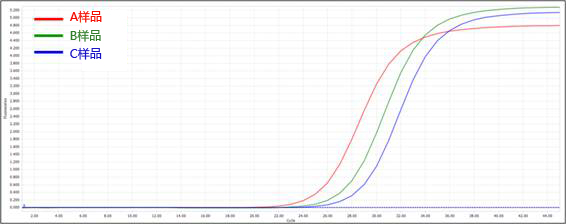
标准曲线
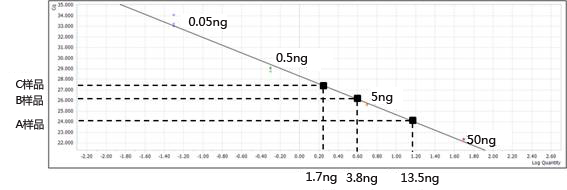
使用Human genomic DNA(Clontech公司),以控制标准曲线。
◆Data 2: LAMP法的利用
使用ISOHAIR EASY及A、B 2人的各3根毛发配制成4 μlDNA提取液,将其作为模板,使用Isothermal Master Mix,利用LAMP引物扩增目标域(IL28B基因),并对其扩增产物进行会合曲线分析。(装置:Genie® II)
|
Isothermal Master Mix |
15.0 µL |
|
LAMP Primers |
2.5 µL |
|
DNA提取液(发根基因组DNA) |
4.0 µL |
|
d.d.H2O |
up to 25.0 µL |
|
扩增 |
63°C、60分钟 |
|
会合曲线分析 |
98°C-75°C、0.05°C/秒 |
<结果>
溶解曲线
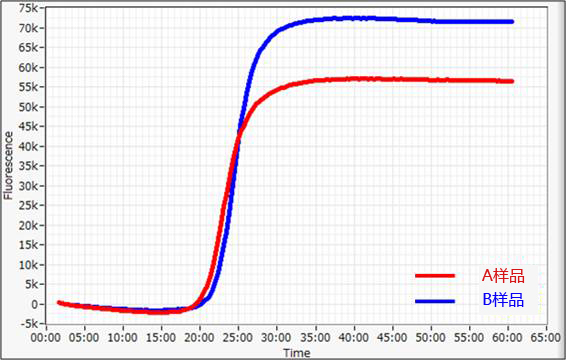
Annealing Derivative
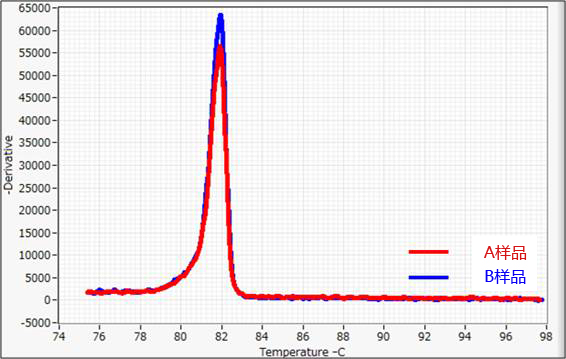
(注)LAMP法的原理是使用4种引物及链置换DNA 合成酶,在一定温度下(65°C左右),使其发生反应,从而扩增基因。
◆备注
-
本产品为实验研究用试剂。请勿用于医疗或其他用途。
◆产品列表
|
ISOHAIR EASY (100次用量) |
|||
|
产品 |
包装 |
保存 |
备注 |
|
ISOHAIR EASY |
1,000 μL × 5瓶 |
-20°C |
|
◆相关产品
-
毛发・爪提取人DNA试剂盒 ISOHAIR
-
教育用生物实验 ISOHAIR Jr.
Q: ISOHAIR(Code No. 315-03403)及ISOHAIR EASY(Code No. 319-07781)的区别是什么?
A: 「ISOHAIR」与「ISOHAIR EASY」的区别如下表所示。ISOHAIR EASY可从发根简单地提取DNA,必须使用有发根的样品。
|
ISOHAIR |
ISOHAIR EASY |
|
|
样品 |
・人毛发: ・小鼠指甲:剪取1~2mm长度的指甲。 |
・人的发根: |
|
操作用时 |
・约1小时 |
・约30分钟 |
|
提取结果 |
・溶解毛发 <完全溶解> |
・使用ISOHAIR EASY进行孵化时,肉眼看不出变化。(肉眼看上去还没有溶解,实际上已有DNA析出) |
Hampton Solubility & Stability Screen
Hampton Solubility & Stability Screen
Solubility & Stability Screen(溶解度和稳定性的屏幕)
应用:溶解性和稳定性屏幕的设计,以协助识别解决方案的条件,促进蛋白质的溶解性和稳定性,并尽量减少蛋白质沉淀。

Solubility & Stability Screen

Solubility & Stability Screen HR2-072
Applications
| A solubility screen, a stability screen, an additive screen for protein assays including ThermoFluor and crystallization |
| Preformulation screening |
| Compatible with Thermofluor , Differential Scanning Fluorimetry (DSF), and Protein Thermal Shift assays |
| 96 sterile filtered reagents |
| 17 classes of reagents and excipients |
| Highly concentrated (10x) reagent formulation |
| Developed at Hampton Research |
Features
Methodologies
| Thermal shift assay |
| Dynamic Light Scattering |
| Use Solubility & Stability Screen along side Slice pH and Solubility & Stability Screen 2 to optimize sample buffer |
Description
Solubility & Stability Screen is designed to assist in the identification of solution conditions which promote protein solubility and stability, and minimize protein precipitation. Solubility & Stability Screen is a solubility screen, a stability screen, and may also be used as an additive screen in the presence of a crystallization reagent.
The Hampton Research Solubility and Stability Screen can evaluate protein solubility, stability and crystallization in the presence of 94 different chemical additives sampling 17 different classes of reagents plus two controls.
Protein solubility and stability are universally required in a wide range of applications, including general biochemical studies, the preparation of proteins in pharmaceuticals, structural biology and crystallization.1-11The preparation of a concentrated, soluble and stable protein sample can often be a difficult task as proteins often aggregate, precipitate or denature.
Thermofluor (also known as Differential Scanning Fluorimetry, DSF and Protein Thermal Shift) provides a rapid, convenient and effective means of identifying subsaturating solution conditions that may also correlate with protein heterogeneity and poor crystallization outcomes.12
Protein solubility and stability is affected by many different chemical factors including pH, buffer type, chemical additives and excipients. pH and buffer type are dominant protein solubility and stability variables and can be evaluated and optimized using the Hampton Research Slice pH kit HR2-070. Slice pH evaluates protein solubility, stability and crystallization versus 20 different buffers over the pH range 3.5-9.6. Chemical additives influencing protein solubility and stability can be evaluated using the Solubility & Stability Screen.
It is widely accepted that protein solubility and stability can be increased by the use of chemical additives.5,15Seventeen classes of reagents are sampled by the Solubility & Stability Screen and each of these classes has been reported as important in improving sample solubility and stability.2-11
The Solubility & Stability Screen is a set of 94 high purity reagents formulated in high purity water (NCCLS/ASTM Type 1+) at 25°C and are 0.22 micron sterile filtered. The 94 solubility and stability reagents are formulated at 2 to 10 times their recommended working concentration. The remaining two reagents are water and a negative (TCA) control. A water control demonstrates the effect of diluting sample as well as sample buffer concentration. TCA, the negative control, demonstrates total sample precipitation, loss of sample solubility and loss of sample stability. The effects of the Solubility & Stability reagents can be compared with this negative control to assist in the identification of reagents promoting sample solubility and stability. 500 microliters of each reagent is supplied in a sterile 96 well polypropylene Deep Well block. The Solubility & Stability Screen reagents are compatible with the sitting or hanging drop vapor diffusion, microbatch, free interface diffusion, sandwich drop vapor diffusion, and dialysis crystallization methods utilizing water soluble reagents.
Whatman 滤膜 10463801 Roby 自动化滤器 25mm,玻璃纤维GF92, 1m 200/盒
Whatman 滤膜 10463801 Roby 自动化滤器 25mm,玻璃纤维GF92, 1m 200/盒 ROBY 25/ GF92 200/PK 8TBS
Whatman 滤膜 10311851 597滤纸1/2折叠240mm/100
Whatman 滤膜 10311851 597滤纸1/2折叠240mm/100 597 FF 240MM 100/PK
Whatman 滤膜 6875-2504 GD/X25针头式滤器0.45m PTFE 1500/盒
Whatman 滤膜 6875-2504 GD/X25针头式滤器0.45m PTFE 1500/盒 GD/X 25/0.45 PTFE 1500/PK
OXOID培养基 CM0491B ISO-SENSITEST BROTH W/OUT STAR500GRA
OXOID培养基 CM0491B ISO-SENSITEST BROTH W/OUT STAR500GRA 698.410975248
Whatman 滤膜 30319367 31ETCHR 62CMx250M ARKAY
Whatman 滤膜 30319367 31ETCHR 62CMx250M ARKAY 31ETCHR 62CMx250M ARKAY
荧光染料57070 Cyanine5.5 hydrazide 50 mg
lumiprobe荧光染料57070 Cyanine5.5 hydrazide 50 mg lumiprobe荧光染料Cyanine5.5 酰肼 50 mg 695
BD培养基 218081 500 g EA Difco Reinforced Clostridial Medium 梭菌强化培养基
BD培养基 218081 500 g EA Difco Reinforced Clostridial Medium 梭菌强化培养基 
RHEODOL SP-L10 椰油脂肪酸山梨糖醇酐 山梨坦椰油酸酯
RHEODOL SP-L10
RHEODOL SP-L10 椰油脂肪酸山梨糖醇酐 山梨坦椰油酸酯
规格
| 化学名称 | 椰油脂肪酸山梨糖醇酐 |
|---|---|
| 国际化妆品成分名 | 山梨坦椰油酸酯 |
| 外观 | 液体 |
| 含量 (%) | 100 |
| 色度 | 10>(Gardner) |
| 凝固点(℃) | 13-14 |
| 酸值 | 4-7 |
| 皂化值 | 158-170 |
| 羟值 | 330-358 |
| 亲水亲油平衡 | 8.6 |
| 溶解度(10%Liq.、25℃) | ・水:溶解性低, ・乙醇:易溶, ・正己烷:溶解性低, ・二甲苯:易溶 |
| SP Value〔(Mpa)1/2〕 | 20.38(Hoy method) |
| 应用 | 药品和化妆品中的乳化剂,颜料色素中的乳化剂和分散剂,润滑油中的乳化剂。 |
| 特性 | 水包油型乳液中的嗜油乳化剂,同样也适用于结合的亲水性乳化剂的油包水型乳液如系列。 |
| 生产地区 | 亚洲 |
| 包装 | 17千克/罐,200千克/桶 |
Whatman 滤膜 30049267 4CHR 7CMx100M REEL EIKEN
Whatman 滤膜 30049267 4CHR 7CMx100M REEL EIKEN 4CHR 7CMx100M REEL EIKEN
whatman,nalgene,merck,millipore,sartorius,pall,thermo fisher中国代理商
whatman品牌介绍及代理商/经销商名单
whatman,nalgene,merck,millipore,sartorius,pall,thermo fisher中国代理商
whatman品牌介绍及代理商/上海总代理商
上海金畔生物科技有限公司代理whatman全线产品
固话总机:021-50837765
订货热线:15221999938
qq号:2743691513 1042640511
微信号:jinpanbio
网 址: www.jinpanbio.com
金畔博客:www.jinpanbio.cn
Email:sales@jinpanbio.com
作为全球过滤系统的标尺,Whatman滤纸以其高质量、可信赖和一切只为客户的宗旨而著称。为人熟知的Whatman Blue Box是实验室过滤的衡量标准。
Whatman隶属世界500强通用电气公司(GE)医疗生命科学部,全球最著名的实验室检测与分离品牌之一,品牌的历史可追溯至1733年,Whatman总部在英格兰肯特郡,在英国、德国和上海设有研发中心,全球有80多个办事处,在美国、英国、德国等拥有现代化工厂,产品和技术服务遍及150多个国家和地区。280年来,Whatman以高质量(Quality)、可靠性(Reliability)和容易操作(Easy to use)而闻名于世,它的“Simplicity”理念致力于使科学发现更迅速、更创造效益和更节省时间,Whatman质量优异的化学分析滤纸、微孔滤膜、过滤器、过滤系统、检测设备和一系列特殊功能品超过3000种,它倡导的“第一次用对,一直都用对”的概念和产品,每天在全世界的工艺规程、标准规范、实验探索的关键环节中应用。
Whatman 滤膜 5305-150 305 15CM 100/PK
Whatman 滤膜 5305-150 305 15CM 100/PK 305 15CM 100/PK
康宁corning 431733 STORAGE BOTTLE,500 mL, 31.7mm HDPE SCREW CAP,PET,S,BK,12/TRAY, 24/CS 12/包
康宁corning 431733 STORAGE BOTTLE,500 mL, 31.7mm HDPE SCREW CAP,PET,S,BK,12/TRAY, 24/CS 12/包 2包/箱 1223.51
L-苹果酸[液体即用型]检测试剂盒 L-Malic Acid Assay Kit (Liquid Ready Reagents) 货号:K-LMALQR Megazyme中文站
L-苹果酸[液体即用型]检测试剂盒
英文名:L-Malic Acid Assay Kit (Liquid Ready Reagents)
货号:K-LMALQR
规格:1100 assays (microplate) / 1100 (auto-analyser)
The L-Malic Acid (Liquid Ready Reagents) test kit is a rapid, simple, reliable and accurate method for the specific measurement and analysis of L-malic acid in wine, beverages, foodstuffs and other materials. Supplied as a “ready to use” liquid stable formulation that is suitable for auto-analyser and microplate formats.
Suitable for auto-analyser and microplate formats.
UV-method suitable for microplate and auto-analyser formats
for the determination of L-Malic Acid in foodstuffs, beverages
and other materials
Principle:
(L-malate dehydrogenase)
(1) L-Malic acid + NAD+ ↔ oxaloacetate + NADH + H+
(glutamate-oxaloacetate transaminase)
(2) Oxaloacetate + L-glutamate → L-aspartate + 2-oxoglutarate
Kit size: 1100 assays (microplate)
/ 1100 (auto-analyser)
Method: Spectrophotometric at 340 nm
Reaction time: ~ 3 min
Detection limit: 166 mg/L (recommended format)
Application examples:
Wine, beer, fruit juices, soft drinks, candies, fruit and vegetables,
bread, cosmetics, pharmaceuticals and other materials (e.g. biological
cultures, samples, etc.)
Method recognition:
Methods based on this principle have been accepted by AOAC, EEC,
EN, NF, NEN, DIN, GOST, OIV, IFU, AIJN and MEBAK
Advantages
- PVP incorporated to prevent tannin inhibition
- “Ready to use” liquid stable formulation
- Very competitive price (cost per test)
- All reagents stable for > 18 Months
- Very rapid reaction (~ 3 min)
- Standard included
- Suitable for microplate and auto-analyser formats
Q1. Should the pH of the sample be adjusted even for samples in acidic media?
The pH of the assay solution after the sample is added should be the same as that of the assay buffer that is supplied with the kit.
Low sample volumes (e.g. 0.1 mL) are not likely to affect the pH of the assay solution and therefore may not require pH adjustment.
Samples above 0.1 mL are more likely to affect the pH of the assay solution and therefore the pH of these samples should be adjusted as described in the data booklet, prior to addition to the assay.
Q2. Sometimes a negative absorbance change is obtained for the blank samples, is this normal? Should the real value (negative absorbance change) or “0” be used in the calculation of results?
Sometimes the addition of the last assay component can cause a small negative absorbance change in the blank samples due to a dilution effect and in such cases it is recommended that the real absorbance values be used in the calculation of results.
Q3. There is an issue with the performance of the kit; the results are not as expected.
If you suspect that the Megazyme test kit is not performing as expected such that expected results are not obtained please do the following:
- Ensure that you have tested the standard sample that is supplied with the Megazyme test kit.
- Send the results of the kit standard, blank samples and the results obtained for your sample, in the relevant MegaCalc spreadsheet (if available) to Megazyme (cs@megazyme.com). Where available the relevant MegaCalc spreadsheet can be downloaded from where the product appears on the Megazyme website.
- State the kit lot number being used (this is found on the outside of the kit box).
- State which assay format was used (refer to the relevant page in the kit booklet if necessary).
- State exact details of any modifications to the standard procedure that is provided by Megazyme.
- State the sample type and describe the sample preparation steps if applicable.
Q4. What is the difference between K-LMAL-58A / 116A, K-LMALAF, K-LMALMQ and K-LMALQR?
Megazyme produces 4 L-malic acid test kits:
K-LMAL-58A / 116A: UV method, automated format for use with auto-analysers.
K-LMALAF: UV method, manual format for use with spectrophotometers.
K-LMALMQ: Colourimetric method, manual format for use with hand held colorimeter.
K-LMALQR: UV method, liquid ready reagents automated format for use with auto-analysers.
Q5. Which L-Malic Acid Kit is recommended for a 96-well microplate format?
Auto-analysers use ~ 0.315 mL reaction volumes and pathlengths between 4-8 mm which is similar to a standard 96-well microplate where a 0.315 mL reaction volume would give a pathlength of ~ 6-7 mm. Therefore, K-LMALAF can be used directly in a 96-well microplate format with minimal assay optimisation.
If preferred, K-LMAL-58A / 116A may also be easily converted for use in a 96-well microplate format. Basically, the assay volumes for the cuvette format must be reduced approximately 10-fold for use in a 96-well microplate. However, some assay optimisation may be required (e.g. increased enzyme concentration etc.) and unlike the cuvette which has a set pathlength of 1 cm, the pathlength in the microplate is dependent upon the volume of liquid in the well.
Therefore to enable the calculation of the amount of analyte in the samples from tests performed in the microplate format one of the following must be done:
- The easiest method is to use a microplate reader that has a pathlength conversion capability (i.e. the microplate reader can detect the pathlength of each well and convert the individual readings to a 1 cm pathlength). This will allow values to be calculated using the MegaCalc calculation software which can be found where the product is located on the Megazyme website.
- Perform a standard curve of the analyte on each microplate that contains test samples and calculate the result of the test samples from the calibration curve (concentration of analyte versus absorbance).
- Perform a standard curve of the analyte in both the cuvette format (i.e. with a 1 cm pathlength) and the 96-well microplate format and use these results to obtain a mean conversion factor between the cuvette values and the microplate values.
L-Malic Acid Kit Recommendation For Microplate Format:
Either K-LMAL-58A / 116A or K-LMALAF is recommended for use in a 96-well microplate format and the main advantages / disadvantages are described below:
K-LMAL-58A / 116A:
The assay volumes of this kit should be reduced by 10-fold for use in a 96-well microplate format (some assay optimisation may be required, e.g. increased enzyme concentration etc.).
The calculation of results is achieved as outlined above in either of points 1, 2 or 3.
The main advantage here is that if this kit is used with a microplate reader that has a pathlength conversion capability, or if results are converted as outlined above in point 3, then this enables easy calculation of results using the K-LMAL-58A / 116A MegaCalc application (available on the Megazyme website where the product is located).
K-LMALAF:
This kit is designed for use in an auto-analyser and therefore can be used without any modification to assay volumes directly in a 96-well microplate format.
This kit has less reagent additions than K-LMAL-58A / 116A.
K-LMALAF does not have a MegaCalc application available to enable easy results calculation which therefore must be achieved as outlined above in either of points 2 or 3.
Q6. Do samples require any specific sample preparation prior to testing with the kits?
The sample preparation is sample dependent, some samples may be tested directly in the assay or after appropriate dilution, however, some samples may require further sample preparation prior to testing. The following are example of sample preparation methods:
(a) Liquid samples: clear, slightly coloured and approximately neutral, liquid samples can be used directly in the assay.
(b) Acidic samples: if > 0.1 mL of an acidic sample is to be used undiluted (such as wine or fruit juice), the pH of the solution should be increased to approx. 9.0 using 2 M NaOH, and the solution incubated at room temperature for 30 min.
(c) Carbon dioxide: samples containing significant quantities of carbon dioxide, such as beer, should be degassed by increasing the pH to approx. 9.0 with 2 M NaOH and gentle stirring, or by stirring with a glass rod.
(d) Coloured samples: an additional sample blank, i.e. sample with no L-MDH, may be necessary in the case of coloured samples.
(e) Strongly coloured samples: if used undiluted, strongly coloured samples should be treated by the addition of 0.2 g of PVPP/10 mL of sample. Shake the tube vigorously for 5 min and then filter through Whatman No. 1 filter paper.
(f) Solid samples: homogenise or crush solid samples in distilled water and filter if necessary.
(g) Samples containing fat: extract such samples with hot water at a temperature above the melting point of the fat, e.g. in a 100 mL volumetric flask. Adjust to room temperature and fill the volumetric flask to the mark with distilled water. Store on ice or in a refrigerator for 15-30 min and then filter. Discard the first few mL of filtrate, and use the clear supernatant (which may be slightly opalescent) for assay. Alternatively, clarify with Carrez reagents.
(h) Samples containing protein: deproteinise samples containing protein by adding an equal volume of ice-cold 1 M perchloric acid with mixing. Centrifuge at 1,500 g for 10 min and neutralise the supernatant with 1 M KOH. Alternatively use Carrez reagents.
Q7. How can I work out how much sample to extract and what dilution of my sample should be used in the kit assay?
Where the amount of analyte in a liquid sample is unknown, it is recommended that a range of sample dilutions are prepared with the aim of obtaining an absorbance change in the assay that is within the linear range.
Where solid samples are analysed, the weight of sample per volume of water used for sample extraction/preparation can be altered to suit, as can the dilution of the extracted sample prior to the addition of the assay, as per liquid samples.
Q8. Can you explain, step by step, how to follow the method and perform the kit assay?
For users who are not familiar with how to use the Megazyme tests kits then it is recommended that they follow this example, e.g. D-Fructose/D-Glucose Assay kit K-FRUGL (http://secure.megazyme.com/D-Fructose-D-Glucose-Assay-Kit):
1. The kit components are listed on pages 2-3 of the kit booklet.
2. Prepare the kit reagents as described on page 3.
3. For separate measurements of glucose and fructose follow procedure A on page 4.
4. Pipette the volumes listed for water, sample, solution 1 and solution 2 into 3 mL, 1 cm pathlength cuvettes. Duplicate sample assays and duplicate blanks are recommended. Mix the contents of each cuvette by inversion (seal the cuvette using parafilm or a plastic cuvette cap – do not use a finger) then after ~3 min record the first absorbance reading of each cuvette at 340 nm (this is reading A1).
5. Then add suspension 3 and mix the contents of each cuvette by inversion. Incubate for 5 minutes then record the absorbance reading of each cuvette at 340 nm (this is reading A2). NB. It is essential that the reaction is compete. To assess this, record the absorbances at ~ 2 minute intervals and until the absorbance plateaus. A stable absorbance indicates that the reaction is complete. If the absorbance continues to increase then continue to record absorbances until it plateaus and only then record absorbance reading A2.
6. Then add suspension 4 and mix the contents of each cuvette by inversion. Incubate for 5 minutes then take absorbance reading of each cuvette at 340 nm (this is reading A3). NB. As above, assess that the reaction has completed by take subsequent readings at ~2 min intervals.
7. For simple, automated results analysis, input the absorbance readings (A1, A2, A3) for samples and blanks into the K-FRUGL MegaCalc.
To ensure that the assay is working, and being performed correctly it is recommend that the test is performed using the standard sample that is provided with the kit and to obtain the expected values before proceeding to test real samples.
It is recommend that new users also watch this video which highlights how to perform the assays.
Many of the other Megazyme test kits follow a similar format.
Q9. Can the sensitivity of the kit assay be increased?
视频
评价晒单
-
100%购买后满意0名用户投票
-
-
100%
-
0%
-
0%
-
-
对自己购买过的商品进行评价,它将成为大家购买参考依据。所有用户都可以对该商品 我要评价
最有帮助的评价(0)
- 暂时还没有任何用户评论
OXOID培养基 CM0549B 孟加拉红氯霉素琼脂基础 ROSE BENGAL CHLORAMPHENICOL AGAR
OXOID培养基 CM0549B 孟加拉红氯霉素琼脂基础 ROSE BENGAL CHLORAMPHENICOL AGAR 1022.38258512
Whatman 滤膜 GN203NPERCSP MUP G2 0.2uM RC 100/PK + HC
Whatman 滤膜 GN203NPERCSP MUP G2 0.2uM RC 100/PK + HC MUP G2 0.2uM RC 100/PK + HC
OXOID培养基 SR0227E Brilliance李斯特菌显色选择性添加剂 CHROMOGENIC LISTERIA SELECT.SUPPLEME
OXOID培养基 SR0227E Brilliance李斯特菌显色选择性添加剂 CHROMOGENIC LISTERIA SELECT.SUPPLEME 330.26475872
Axygen PCR-0104-C 0.1ml四联管(含盖) 250排/包,10包/箱
Axygen PCR-0104-C 0.1ml四联管(含盖) 250排/包,10包/箱 21369.15 
Whatman 滤膜 1001-6675 GR 1 22CMx100M 1/PK
Whatman 滤膜 1001-6675 GR 1 22CMx100M 1/PK GR 1 22CMx100M 1/PK
Pall颇尔滤膜 12121 FILLING MACHINE CAPSULE 5UM
Pall颇尔滤膜 12121 FILLING MACHINE CAPSULE 5UM 235 1878


